Trondheim
Trondheim (UK: /ˈtrɒn(d)haɪm/ TRON(D)-hyme, US: /ˈtrɒnheɪm/ TRON-haym,[5][6] Urban East Norwegian: [ˈtrɔ̂nː(h)æɪm] (![]() listen); Southern Sami: Tråante), historically Kaupangen, Nidaros and Trondhjem (local pronunciation: [ˈtrɔ̂nːjæm]), is a city and municipality in Trøndelag county, Norway. It has a population of 205,332 as of 2020,[7] and is the third most populous municipality in Norway, although the fourth largest urban area. Trondheim lies on the south shore of Trondheim Fjord at the mouth of the River Nidelva. Among the major technology-oriented institutions headquartered in Trondheim are the Norwegian University of Science and Technology (NTNU), the Foundation for Scientific and Industrial Research (SINTEF), and St. Olavs University Hospital.
listen); Southern Sami: Tråante), historically Kaupangen, Nidaros and Trondhjem (local pronunciation: [ˈtrɔ̂nːjæm]), is a city and municipality in Trøndelag county, Norway. It has a population of 205,332 as of 2020,[7] and is the third most populous municipality in Norway, although the fourth largest urban area. Trondheim lies on the south shore of Trondheim Fjord at the mouth of the River Nidelva. Among the major technology-oriented institutions headquartered in Trondheim are the Norwegian University of Science and Technology (NTNU), the Foundation for Scientific and Industrial Research (SINTEF), and St. Olavs University Hospital.
Trondheim | |
|---|---|
City | |
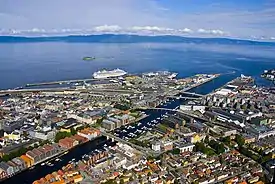   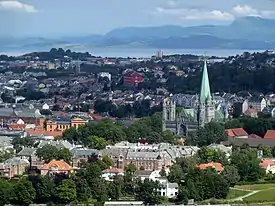   From upper left: Outer city with Nidelva and sea port, Verftsbrua bridge, Trondheim Central Station at Brattøra, Inner city with Nidaros Cathedral, Old Town Bridge with Lykkens portal, Rosenborgbassenget at Nedre Elvehavn | |
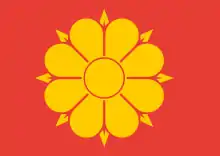 Flag 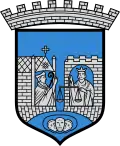 Coat of arms | |
| Nickname(s): Stiftstaden (English: "The Diocese City") | |
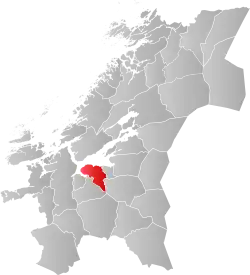 Location of the municipality | |
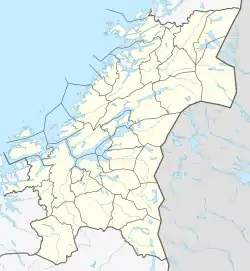 Trondheim  Trondheim | |
| Coordinates: 63°25′47″N 10°23′36″E | |
| Country | Norway |
| Municipality | Trondheim |
| County | Trøndelag |
| District | Trondheim Region |
| Established | 997 |
| Government | |
| • Mayor | Rita Ottervik (Ap) |
| Area | |
| • City | 321.81 km2 (124.25 sq mi) |
| • Urban | 342.30 km2 (132.16 sq mi) |
| • Metro | 7,295 km2 (2,817 sq mi) |
| Population (18 November 2020) | |
| • City | 210 496 |
| • Urban | 186,364[2] |
| • Metro | 279,234 |
| • Metro density | 38/km2 (99/sq mi) |
| • Municipality/Urban rank | 3rd/4th |
| • Metro rank | 4th |
| Demonym(s) | Trondheimer, Trondhjemmer, |
| Time zone | UTC+01:00 (CET) |
| • Summer (DST) | UTC+02:00 (CEST) |
| Website | www |
| Year | Pop. | ±% |
|---|---|---|
| 1769 | 11,315 | — |
| 1951 | 56,582 | +400.1% |
| 1960 | 59,286 | +4.8% |
| 1970 | 126,190 | +112.8% |
| 1980 | 134,726 | +6.8% |
| 1990 | 137,346 | +1.9% |
| 2000 | 148,859 | +8.4% |
| 2010 | 171,540 | +15.2% |
| 2014 | 183,960 | +7.2% |
| Source: Statistics Norway[3][4] | ||
The settlement was founded in 997 as a trading post, and it served as the capital of Norway during the Viking Age until 1217. From 1152 to 1537, the city was the seat of the Catholic Archdiocese of Nidaros; since then, it has remained the seat of the Lutheran Diocese of Nidaros and the Nidaros Cathedral. It was incorporated in 1838. The current municipality dates from 1964, when Trondheim merged with Byneset, Leinstrand, Strinda and Tiller, and the municipality was further expanded 1 January 2020 when Trondheim merged with Klæbu.
Trondheim has a mild climate for its northerly latitude, resulting in moderate summers and winters that often remain above the freezing point in seaside areas. At higher elevations, though, the microclimate is colder and snowier.
The city functions as the seat of the County Mayor of Trøndelag county, but not as the administrative centre, which is Steinkjer. This is to make the county administration not too centralized.
Trondheim is home to football club Rosenborg, the greatest and Norway's most successful team, as well as Granåsen Ski Centre which has hosted the World Championship in Nordic Skiing.
Names and etymology

The city was originally given the name by Olav Tryggvason. It was for a long time called Nidaros (English: river Nid's outlet), or Niðaróss in the Old Norse spelling. But it was also just called kaupangr ("city") or, more specifically, kaupangr í Þróndheimi ("the city in the district Þróndheimr", i.e. Trøndelag). The name Trøndelag, Norse Þrǿndalǫg, originally meant «the law area of the Trønder (people)» (literally Trønder-law). The first part is the genitive plural of the popular name þrǿndr, «trøndere», which is an old present participle of the verb þróask, «to grow» (with the same root as in «thrive»), (Peterson, Lena. 2007. Nordiskt runnamnslexikon. Femte, reviderade utgåvan, p237) .and thus can be translated as «the strong, fertile. (Trondheim byleksikon Arkivert 22. desember 2015 hos Wayback Machine. /; bokmal wiki, https://no.wikipedia.org/wiki/Tr%C3%B8ndelag)%5B%5D
During the late Middle Ages people started to call the city just Þróndheimr. In the Dano-Norwegian period, during the years as a provincial town in the united kingdoms of Denmark–Norway, the city name was spelt Trondhjem.
Following the example set by the renaming of the capital Kristiania to Oslo, Nidaros was reintroduced as the official name of the city for a brief period from 1 January 1930 until 6 March 1931. The name was restored in order to reaffirm the city's link with its glorious past, despite the fact that a 1928 referendum on the name of the city had resulted in 17,163 votes in favour of Trondhjem and only 1,508 votes in favour of Nidaros.[8] Public outrage later in the same year, even taking the form of riots, forced the Storting to settle for the medieval city name Trondheim. The name of the diocese was, however, changed from Trondhjem stift to Nidaros bispedømme (English: Diocese of Nidaros) in 1918.
Trondheim was briefly named Drontheim during the Second World War, as a German exonym.
History
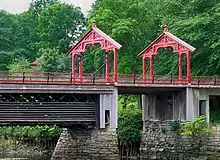
Trondheim was named Kaupangen (English: market place or trading place) by Viking King Olav Tryggvason in 997 CE.[9] Shortly thereafter it came to be called Nidaros. In the beginning it was frequently used as a military retainer (Old Norse: "hird"-man) of King Olav I. It was frequently used as the seat of the king, and was the capital of Norway until 1217.
People have been living in the region for thousands of years as evidenced by the rock carvings in central Norway, the Nøstvet and Lihult cultures and the Corded Ware culture. In ancient times, the Kings of Norway were hailed at Øretinget in Trondheim, the place for the assembly of all free men by the mouth of the River Nidelva. Harald Fairhair (865–933) was hailed as the king here, as was his son, Haakon I, called 'the Good'. The battle of Kalvskinnet took place in Trondheim in 1179: King Sverre Sigurdsson and his Birkebeiner warriors were victorious against Erling Skakke (a rival to the throne). Some scholars believe that the famous Lewis chessmen, 12th century chess pieces carved from walrus ivory found in the Hebrides and now at the British Museum, may have been made in Trondheim.[10]
Trondheim was the seat of the Archbishop of Nidaros for Norway from 1152, which operated from the Archbishop's Palace. Due to the introduction of Lutheran Protestantism in 1537, the last Archbishop, Olav Engelbrektsson, had to flee from the city to the Netherlands, where he died in present-day Lier, Belgium.
The city has experienced several major fires. Since much of the city was made of wooden buildings, many of the fires caused severe damage. Great fires ravaged the city in 1598, 1651, 1681, 1708, twice in 1717, 1742, 1788, 1841 and 1842; however, these were only the worst cases and there have been several smaller fires in the city. The 1651 fire destroyed 90% of all buildings within the city limits. The fire in 1681 (the "Horneman Fire") led to an almost total reconstruction of the city, overseen by General Johan Caspar von Cicignon, originally from Luxembourg. Broad avenues like Munkegata were created, with no regard for property rights, in order to stop the next fire. At the time, the city had a population of under 10,000 inhabitants, with most living in the downtown area.[11]
After the Treaty of Roskilde on 26 February 1658, Trondheim and the rest of Trøndelag, became Swedish territory for a brief period, but the area was reconquered 10 months later. The conflict was finally settled by the Treaty of Copenhagen on 27 May 1660.
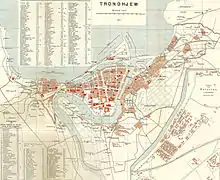
During the Second World War, Trondheim was occupied by Nazi Germany from 9 April 1940, the first day of the invasion of Norway, until the end of the war in Europe, 8 May 1945. The German invasion force consisted of the German cruiser Admiral Hipper, 4 destroyers and 1700 Austrian Mountain troops. Other than a coastal battery opening fire, there was no resistance to the invasion on 9 April at 5 AM. On 14 and 17 April, British and French forces landed near Trondheim in a failed attempt to liberate Trondheim as part of the Namsos Campaign.[12] During the occupation, Trondheim was the home of the notorious Norwegian Gestapo agent, Henry Rinnan, who operated from a nearby villa and infiltrated Norwegian Resistance groups. The city and its citizens were also subject to harsh treatment by the occupying powers, including the imposition of martial law in October 1942. During this time the Germans turned the city and its environs into a major base for submarines (which included building the large submarine base and bunker DORA I), and also contemplated a scheme to build a new city for 300,000 inhabitants, Nordstern ("Northern Star"), centred 15 kilometres (9 miles) southwest of Trondheim, near the wetlands of Øysand in the outskirts of Melhus municipality. This new metropolis was to be accompanied by a massively expanded version of the already existing naval base, which was intended to become the primary future stronghold of the German Kriegsmarine. Today, there are few physical remains of this enormous construction project.[13]
Municipal history
The city of Trondheim was established on 1 January 1838 (see formannskapsdistrikt). On 1 January 1864, part of Strinda (population: 1,229) was amalgamated with Trondheim. Then, on 1 January 1893, another part of Strinda (population: 4,097) was transferred to Trondheim. On 1 January 1952, the Lade area of Strinda (population: 2,230) was transferred to Trondheim. On 1 January 1964, a major municipal merger took place: the neighbouring municipalities of Leinstrand (population: 4,193), Byneset (population: 2,049), Strinda (population: 44,600), and Tiller (population: 3,595) were all merged with the city of Trondheim (population: 56,982), which nearly doubled the population of the municipality.[14] On 1 January 2020, the neighboring Klæbu Municipality (population: 6,050) was merged with Trondheim Municipality.[15]
Coat of arms and seal
The coat of arms dates back to the 13th century. To the left, there is an archbishop with his staff and mitre in a church archway. On the right, a crowned king holding scales in a castle archway. These two pictures rest on a base which forms an arch. Underneath that arch, are three male heads which symbolise the city's rank as Norway's first capital and the archbishop's place of residence. The scales symbolise justice and the motif is based on the political philosophy of the 13th century, where the balance of power between king and church was an important issue. The three heads at the bottom may symbolise the city council. The motif is unique in Norwegian municipal heraldry, but similar motifs are found in bishopric cities on the continent. The design of the coat-of-arms that was adopted in 1897, and is still used today, was made by Håkon Thorsen.[16]
Geography
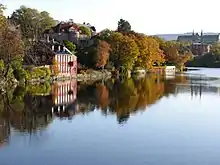
Trondheim is situated where the River Nidelva meets Trondheim Fjord with an excellent harbour and sheltered condition. The river used to be deep enough for most boats in the Middle Ages. An avalanche of mud and stones made it less navigable and partly ruined the harbour in the mid-17th century. The municipality's top elevation is the Storheia hill, 565 metres (1,854 ft) above sea level. At the summer solstice, the sun rises at 03:00 and sets at 23:40, but stays just below the horizon–there is no darkness (no need for artificial lighting outdoors) from 23 May to 19 July under cloud-free conditions.[17] At the winter solstice, the sun rises at 10:01, stays very low above the horizon (at midday its altitude is slightly more than 3 degrees over the horizon), and sets at 14:31.
Climate

Trondheim city has an oceanic climate (Cfb) or humid continental climate (Dfb), depending on the winter threshold used (0 °C or −3 °C). The part of the municipality further away from the fjord has slightly colder winters, while the part close to the fjord has the mildest winters. Trondheim is mostly sheltered from the strong south and southwesterly winds which can occur along the outer seaboard but is more exposed to northwesterly winds. As with the rest of Norway, the weather is dependent on the weather pattern. High pressure over Central Norway or to the east gives sunny weather which can last for weeks. Conversely, Atlantic Lows can also dominate for weeks, and both patterns can happen all year. This was demonstrated in 2020 when May saw northwesterlies with cold air from the Greenland Sea lasting three weeks into the month, and snowfall in mid-May, setting a new record for snow in May. The next month, high pressure and weeks with southeasterlies gave the warmest June on record, with 345 sun hours and Trondheim Airport recording a new record high 34.3 °C (94 °F), Norway's warmest high in 2020.
Trondheim experiences moderate snowfall from November to March,[18] but mixed with mild weather and rainfall. There are on average 14 days each winter with at least 25 cm (10 in) of snow cover on the ground and 22 days with a daily minimum temperature of −10 °C (14 °F) or less (1971–2000, airport). There is often more snow and later snowmelt in suburban areas at a higher elevation, with good skiing conditions in Bymarka. All the monthly record lows are from 1955 or older, with half of them from before 1920. The last overnight frost in June was in 1958, and the coldest night in May after year 2000 had low −2.7 °C. The May record low is from 1900, 3.7 °C colder than the second coldest May night. The all-time low −26 °C (−14.8 °F) was recorded February 1899. The all-time high 35 °C (95 °F) was recorded 22 July 1901. The warmest month on record is July 2014 with mean 19.5 °C (67.1 °F) and average daily high 24.9 °C (76.8 °F) (airport). The coldest month on record is February 1966 with mean −9.9 °C (14.2 °F) and average daily low −14.2 °C (6.4 °F) (airport). The average date for the first overnight freeze (below 0 °C (32.0 °F)) in autumn is 9 October (1981–2010 average, airport).[19]
The earliest weather stations were located closer to the city centre, from 1945 onwards the weather station has been located at a higher elevation (Voll, 127 m and Tyholt, 113 m), therefore being slightly colder.
A new sunrecorder was established by met.no in the city at Gløshaugen (NTNU) December 2015, recording more sunhrs than earlier sunrecorder, which had terrain blocking issues.[20] There are on average 229 sunhours in July (based 2016–2020).[21] Trondheim recorded 197 sunhours in October 2016 beating the previous national record for October. In April 2019, Trondheim recorded 308 sunhours, setting a new national record for April.[22][23] In contrast, December 2016 only recorded 10 sunhours.
| Climate data for Trondheim 1981–2010 (Voll, 127 m, extremes 1870–present includes earlier stations, sunhrs 2016–2020 Gløshaugen/met.no) | |||||||||||||
|---|---|---|---|---|---|---|---|---|---|---|---|---|---|
| Month | Jan | Feb | Mar | Apr | May | Jun | Jul | Aug | Sep | Oct | Nov | Dec | Year |
| Record high °C (°F) | 13.5 (56.3) |
12.6 (54.7) |
14.6 (58.3) |
22.0 (71.6) |
26.9 (80.4) |
31.2 (88.2) |
35.0 (95.0) |
30.4 (86.7) |
26.0 (78.8) |
21.8 (71.2) |
15.4 (59.7) |
13.2 (55.8) |
35.0 (95.0) |
| Average high °C (°F) | 1.2 (34.2) |
1.8 (35.2) |
4.2 (39.6) |
8.8 (47.8) |
13.7 (56.7) |
16.3 (61.3) |
19.0 (66.2) |
18.0 (64.4) |
14.6 (58.3) |
8.9 (48.0) |
4.7 (40.5) |
2.1 (35.8) |
9.4 (49.0) |
| Daily mean °C (°F) | −1.3 (29.7) |
−1.1 (30.0) |
0.7 (33.3) |
4.8 (40.6) |
9.1 (48.4) |
12.1 (53.8) |
15.0 (59.0) |
14.2 (57.6) |
10.6 (51.1) |
5.9 (42.6) |
2.0 (35.6) |
−0.8 (30.6) |
5.9 (42.7) |
| Average low °C (°F) | −4.0 (24.8) |
−3.7 (25.3) |
−2.2 (28.0) |
1.5 (34.7) |
5.3 (41.5) |
8.5 (47.3) |
11.4 (52.5) |
10.8 (51.4) |
7.9 (46.2) |
3.0 (37.4) |
−0.5 (31.1) |
−3.3 (26.1) |
2.9 (37.2) |
| Record low °C (°F) | −25.0 (−13.0) |
−26.0 (−14.8) |
−22.7 (−8.9) |
−15.3 (4.5) |
−9.6 (14.7) |
−0.8 (30.6) |
0.6 (33.1) |
1.0 (33.8) |
−3.5 (25.7) |
−12.6 (9.3) |
−18.7 (−1.7) |
−24.0 (−11.2) |
−26.0 (−14.8) |
| Average precipitation mm (inches) | 72.6 (2.86) |
67.9 (2.67) |
72.2 (2.84) |
51.5 (2.03) |
43.4 (1.71) |
70.8 (2.79) |
75.6 (2.98) |
79.6 (3.13) |
84.2 (3.31) |
78.4 (3.09) |
66.8 (2.63) |
78.1 (3.07) |
841.1 (33.11) |
| Average precipitation days (≥ 1.0 mm) | 13 | 12 | 13 | 12 | 10 | 13 | 11 | 12 | 12 | 14 | 12 | 13 | 147 |
| Mean monthly sunshine hours | 34 | 71 | 124 | 205 | 236 | 234 | 229 | 167 | 130 | 116 | 46 | 16 | 1,608 |
| Source 1: eklima.met.no[24] | |||||||||||||
| Source 2: Meteo-climat[25] | |||||||||||||
| Climate data for Trondheim Airport Værnes 1991–2020 (12 m, extremes 1946–2020, sunhrs 2016–2020) | |||||||||||||
|---|---|---|---|---|---|---|---|---|---|---|---|---|---|
| Month | Jan | Feb | Mar | Apr | May | Jun | Jul | Aug | Sep | Oct | Nov | Dec | Year |
| Record high °C (°F) | 13.7 (56.7) |
13.8 (56.8) |
15.7 (60.3) |
23.3 (73.9) |
27.9 (82.2) |
34.3 (93.7) |
33.5 (92.3) |
31.3 (88.3) |
27.9 (82.2) |
22.1 (71.8) |
16.1 (61.0) |
13.1 (55.6) |
34.3 (93.7) |
| Average high °C (°F) | 1.9 (35.4) |
2.0 (35.6) |
4.6 (40.3) |
9.3 (48.7) |
13.8 (56.8) |
17.1 (62.8) |
19.9 (67.8) |
19.1 (66.4) |
15.0 (59.0) |
9.3 (48.7) |
4.8 (40.6) |
2.2 (36.0) |
9.9 (49.8) |
| Daily mean °C (°F) | −1.1 (30.0) |
−1.1 (30.0) |
1 (34) |
5.1 (41.2) |
9.2 (48.6) |
12.6 (54.7) |
15.2 (59.4) |
14.6 (58.3) |
11 (52) |
5.8 (42.4) |
1.7 (35.1) |
−0.7 (30.7) |
6.1 (43.0) |
| Average low °C (°F) | −4.1 (24.6) |
−4.1 (24.6) |
−2.2 (28.0) |
1.4 (34.5) |
5.3 (41.5) |
8.9 (48.0) |
11.4 (52.5) |
11.0 (51.8) |
7.8 (46.0) |
2.9 (37.2) |
−1.0 (30.2) |
−4.1 (24.6) |
2.8 (37.0) |
| Record low °C (°F) | −25.6 (−14.1) |
−25.5 (−13.9) |
−23.0 (−9.4) |
−13.9 (7.0) |
−4.7 (23.5) |
−0.2 (31.6) |
2.3 (36.1) |
−0.3 (31.5) |
−4.9 (23.2) |
−10.8 (12.6) |
−19.0 (−2.2) |
−23.5 (−10.3) |
−25.6 (−14.1) |
| Average precipitation mm (inches) | 64.6 (2.54) |
63.9 (2.52) |
61.3 (2.41) |
42.9 (1.69) |
52.7 (2.07) |
76.1 (3.00) |
74.4 (2.93) |
82.8 (3.26) |
88.9 (3.50) |
77 (3.0) |
64.4 (2.54) |
75 (3.0) |
824 (32.46) |
| Mean monthly sunshine hours | 34 | 71 | 124 | 205 | 236 | 234 | 229 | 167 | 130 | 116 | 46 | 16 | 1,608 |
| Source: Seklima [26] | |||||||||||||

Fauna
The city has various wetland habitats. among which there is the Gaulosen. The observation tower accommodates for birdwatching and providing information about birdlife.[27]
Despite Trondheim being Norway's third largest city, wild animals can be seen. Otters and beavers thrive in Nidelva and Bymarka.[28] Badgers and red foxes are not uncommon sights. Moose and deer are common in the hills surrounding the city, and might wander into the city, especially in May when the one-year-olds are chased away by their mothers, or in late winter when food grows scarce in the snow-covered higher regions. From 2002 until 2017, a wolverine lived in Bymarka.[29][30]
Cityscape and sites

Most of Trondheim city centre is scattered with small speciality shops. However, the main shopping area is concentrated around the pedestrianised streets Nordre gate (English: Northern street), Olav Tryggvasons gate and Thomas Angells gate even though the rest of the city centre is provided with everything from old, well-established companies to new, hip and trendy shops.
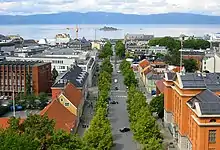
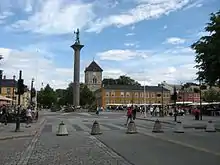
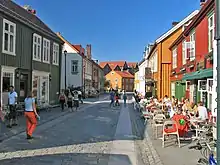
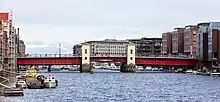
In the mid-to-late 1990s, the area surrounding the old drydock and ship construction buildings of the defunct Trondhjems mekaniske Værksted shipbuilding company at the Nedre Elvehavn was renovated and old industrial buildings were torn down to make way for condominiums. A shopping centre was also built, known as Solsiden (The Sunny Side). This is a popular residential and shopping area, especially for young people.
DORA 1 is a German submarine base that housed the 13th U-boat Flotilla during the Second World War occupation of Norway. Today the bunker houses various archives, among them the city archives, the university and state archives. More recently, DORA has been used as a concert venue.
Kristiansten Fortress, built 1681–1684, is located on a hill east of Trondheim. It repelled the invading Swedes in 1718, but was decommissioned in 1816 by Crown Prince Regent Charles John.
A statue of Olav Tryggvason, the founder of Trondheim, is located in the city's central square, mounted on top of an obelisk. The statue base is also a sun dial, but it is calibrated to UTC+1 so that the reading is inaccurate by one hour in the summer.
The islet Munkholmen is a popular tourist attraction and recreation site. The islet has served as a place of execution, a monastery, a fortress, prison, and a Second World War anti-aircraft gun station.
Stiftsgården is the royal residence in Trondheim, originally constructed in 1774 by Cecilie Christine Schøller. At 140 rooms constituting 4,000 square metres (43,056 sq ft), it is possibly the largest wooden building in Northern Europe and has been used by royals and their guests since 1800.
A statue of Leif Ericson is located at the seaside, close to the old Customs Building, the cruise ship facilities and the new swimming hall. The statue is a replica, the original being located at a Seattle marina.
Nidaros Cathedral
The Nidaros Cathedral and the Archbishop's Palace are located side by side in the middle of the city centre. The cathedral, built from 1070 on, is the most important Gothic monument in Norway and was Northern Europe's most important Christian pilgrimage site during the Middle Ages,[31] with pilgrimage routes leading to it from Oslo in southern Norway and from the Jämtland and Värmland regions of Sweden. Today, it is the northernmost medieval cathedral in the world, and the second-largest in Scandinavia.
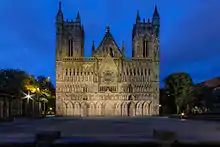
During the Middle Ages, and again after independence was restored in 1814, the Nidaros Cathedral was the coronation church of the Norwegian kings. King Haakon VII was the last monarch to be crowned there, in 1906. Starting with King Olav V in 1957, coronation was replaced by consecration. In 1991, the present King Harald V and Queen Sonja were consecrated in the cathedral.[32] On 24 May 2002, their daughter Princess Märtha Louise married the writer Ari Behn in the cathedral.[33]
The Pilgrim's Route (Pilegrimsleden) to the site of Saint Olufs's tomb at Nidaros Cathedral, has recently been re-instated. Also known as St. Olav's Way, (Sankt Olavs vei), the main route, which is approximately 640 kilometres (400 mi) long, starts in Oslo and heads North, along Lake Mjøsa, up the valley Gudbrandsdalen, over the mountain range Dovrefjell and down the Oppdal valley to end at Nidaros Cathedral in Trondheim. There is a Pilgrim's Office in Oslo which gives advice to pilgrims and a Pilgrim Centre in Trondheim, under the aegis of the cathedral, which awards certificates to successful pilgrims upon the completion of their journey.[34][35]
Other churches
The Lutheran Church of Norway has 21 churches within the municipality of Trondheim. They are all a part of the Diocese of Nidaros, which is based in Trondheim at the Nidaros Cathedral. Many of the churches are several hundred years old, with a couple which were built almost 1,000 years ago.
| Deanery (Prosti) | Parish (Sokn) | Church name | Year built | Location |
|---|---|---|---|---|
| Nidaros | Nidaros Domkirke og Vår Frue | Nidaros Cathedral | 1070–1300 | Midtbyen |
| Vår Frue Church | 1200 | Midtbyen | ||
| Bakklandet | Bakke Church | 1715 | Bakklandet | |
| Lade | Lade Church | 1190 | Lade | |
| Lademoen | Lademoen Church | 1905 | Lademoen | |
| Byåsen | Byåsen | Byåsen Church | 1974 | Byåsen |
| Ilen | Ilen Church | 1889 | Ila | |
| Sverresborg | Havstein Church | 1857 | Sverresborg | |
| Heimdal | Byneset | Byneset Church | 1180 | Byneset |
| Heimdal | Heimdal Church | 1960 | Heimdal | |
| Kolstad | Kolstad Church | 1986 | Kolstad | |
| Leinstrand | Leinstrand Church | 1673 | Leinstrand | |
| Tiller | Tiller Church | 1901 | Tiller | |
| Strinda | Berg | Berg Church | 1972 | Berg |
| Bratsberg | Bratsberg Church | 1850 | Bratsberg | |
| Charlottenlund | Charlottenlund Church | 1973 | Charlottenlund | |
| Hoeggen | Hoeggen Church | 1997 | Lerkendal | |
| Ranheim | Ranheim Church | 1933 | Ranheim | |
| Strinda | Strinda Church | 1900 | Strinda | |
| Strindheim | Strindheim Church | 1979 | Strindheim | |
| Tempe | Tempe Church | 1960 | Lerkendal |
The Roman Catholic Sankt Olav domkirke is the cathedral episcopal see of the exempt Territorial Prelature of Trondheim. Being located across the street from the Nidaros Cathedral, the two of them form an unofficial religious quarter along with a synagogue, a Baptist church, a Salvation Army office, and the 8-auditorium cinema Prinsen kinosenter.
Museums
Sverresborg, also named Zion after King David's castle in Jerusalem, was a fortification built by Sverre Sigurdsson. It is now an open-air museum, consisting of more than 60 buildings. The castle was originally built in 1182–1183, but did not last for long as it was burned down in 1188. However, the Sverresaga indicates it had been restored by 1197.[36]
The Trondheim Science Center (Norwegian: Vitensenteret i Trondheim) is a scientific hands-on experience center. The NTNU University Museum (Norwegian: NTNU Vitenskapsmuseet) is part of the Norwegian University of Science and Technology. There are also a variety of small history, science and natural history museums, such as the Trondheim Maritime Museum, the Armoury, adjacent to the Archbishops's Palace, Kristiansten Fortress, the music and musical instrument museum Ringve National Museum, Ringve Botanical Garden, the Trondheim Tramway Museum, and the Jewish Museum, co-located with the city's synagogue, which is among the northernmost in the world.
Rockheim (Norwegian: Det nasjonale opplevelsessenteret for pop og rock, The National Discovery Center for Pop and Rock) opened at the Pier in August 2010. It is located inside an old warehouse, but characterised by an easily recognisable roof in the shape of a box. "The box" is decorated by thousands of tiny lights that change in a variety of colours and patterns, and is a landmark in the cityscape – especially on dark winter evenings.
Prison
Vollan District Jail (Norwegian: Vollan kretsfengsel) was a jail during the nazi occupation of Norway and was used to imprison both prisoners of war and criminals. Vollan was not considered a concentration camp.[37] In a summary of prisoners of war in Norway, numerous prisoners were registered at Vollan. One of its roles was as a transit camp for political prisoners. Many prisoners were taken from Vollan to Kristiansten Fortress and shot. The prisoners at Vollan were interrogated at the Mission Hotel in Trondheim. Some were also interrogated by Henry Rinnan and his gang.[37] It was closed in 1971 after the opening of Trondheim Prison at Tunga.
Trondheim Prison (Norwegian: Trondheim fengsel) is a prison that belongs to the Northern Region of the Norwegian Correctional Services.[38] The prison can house 184 inmates.
It consists of four main departments:
- Nermarka ("Tunga") – closed department
- Detention department (no: Forvaringsavdelingen) at Nermarka
- Leira – open division. Through joint positive activities, the individual inmate on certain conditions teaches to be responsible with other people.[39]
- division Kongens gt. – halfway house, located in downtown Trondheim.
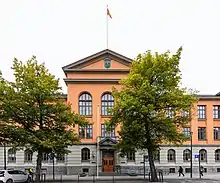
Government
The municipality is governed by a municipal council of elected representatives, which in turn elect a mayor.
On 1 January 2005, the city was reorganized from five boroughs into four, with each of these having separate social services offices. The current boroughs are Midtbyen (44,967 inhabitants), Østbyen (42,707 inhabitants), Lerkendal (46,603 inhabitants) and Heimdal (30,744) inhabitants. The Population statistics listed are as of 1 January 2008. Prior to 2005, Trondheim was divided into the boroughs Sentrum, Strinda, Nardo, Byåsen and Heimdal.
Municipal council
The city council (Bystyret) of Trondheim is made up of 67 representatives that are elected every four years. Prior to 2011, there were 85 city council members, but this number was reduced to 67 in 2011. The party breakdown of the council is as follows:
| Party Name (in Norwegian) | Number of representatives | |
|---|---|---|
| Labour Party (Arbeiderpartiet) | 17 | |
| Progress Party (Fremskrittspartiet) | 4 | |
| Green Party (Miljøpartiet De Grønne) | 7 | |
| Conservative Party (Høyre) | 14 | |
| Christian Democratic Party (Kristelig Folkeparti) | 1 | |
| Pensioners' Party (Pensjonistpartiet) | 3 | |
| Red Party (Rødt) | 5 | |
| Centre Party (Senterpartiet) | 5 | |
| Socialist Left Party (Sosialistisk Venstreparti) | 8 | |
| Liberal Party (Venstre) | 3 | |
| Total number of members: | 67 | |
| Party Name (in Norwegian) | Number of representatives | |
|---|---|---|
| Labour Party (Arbeiderpartiet) | 28 | |
| Progress Party (Fremskrittspartiet) | 4 | |
| Green Party (Miljøpartiet De Grønne) | 5 | |
| Conservative Party (Høyre) | 14 | |
| Christian Democratic Party (Kristelig Folkeparti) | 2 | |
| Pensioners' Party (Pensjonistpartiet) | 2 | |
| Red Party (Rødt) | 2 | |
| Centre Party (Senterpartiet) | 2 | |
| Socialist Left Party (Sosialistisk Venstreparti) | 4 | |
| Liberal Party (Venstre) | 4 | |
| Total number of members: | 67 | |
| Party Name (in Norwegian) | Number of representatives | |
|---|---|---|
| Labour Party (Arbeiderpartiet) | 27 | |
| Progress Party (Fremskrittspartiet) | 6 | |
| Green Party (Miljøpartiet De Grønne) | 2 | |
| Conservative Party (Høyre) | 18 | |
| Christian Democratic Party (Kristelig Folkeparti) | 2 | |
| Pensioners' Party (Pensjonistpartiet) | 1 | |
| Red Party (Rødt) | 2 | |
| Centre Party (Senterpartiet) | 1 | |
| Socialist Left Party (Sosialistisk Venstreparti) | 4 | |
| Liberal Party (Venstre) | 4 | |
| Total number of members: | 67 | |
| Party Name (in Norwegian) | Number of representatives | |
|---|---|---|
| Labour Party (Arbeiderpartiet) | 37 | |
| The Democrats (Demokratene) | 1 | |
| Progress Party (Fremskrittspartiet) | 13 | |
| Green Party (Miljøpartiet De Grønne) | 2 | |
| Conservative Party (Høyre) | 13 | |
| Christian Democratic Party (Kristelig Folkeparti) | 3 | |
| Pensioners' Party (Pensjonistpartiet) | 1 | |
| Red Electoral Alliance (Rød Valgallianse) | 3 | |
| Centre Party (Senterpartiet) | 2 | |
| Socialist Left Party (Sosialistisk Venstreparti) | 7 | |
| Liberal Party (Venstre) | 3 | |
| Total number of members: | 85 | |
| Party Name (in Norwegian) | Number of representatives | |
|---|---|---|
| Labour Party (Arbeiderpartiet) | 26 | |
| The Democrats (Demokratene) | 1 | |
| Progress Party (Fremskrittspartiet) | 10 | |
| Green Party (Miljøpartiet De Grønne) | 1 | |
| Conservative Party (Høyre) | 18 | |
| Christian Democratic Party (Kristelig Folkeparti) | 3 | |
| Pensioners' Party (Pensjonistpartiet) | 4 | |
| Red Electoral Alliance (Rød Valgallianse) | 2 | |
| Centre Party (Senterpartiet) | 3 | |
| Socialist Left Party (Sosialistisk Venstreparti) | 15 | |
| Liberal Party (Venstre) | 2 | |
| Total number of members: | 85 | |
| Party Name (in Norwegian) | Number of representatives | |
|---|---|---|
| Labour Party (Arbeiderpartiet) | 26 | |
| Progress Party (Fremskrittspartiet) | 7 | |
| Green Party (Miljøpartiet De Grønne) | 1 | |
| Conservative Party (Høyre) | 30 | |
| Christian Democratic Party (Kristelig Folkeparti) | 4 | |
| Pensioners' Party (Pensjonistpartiet) | 1 | |
| Red Electoral Alliance (Rød Valgallianse) | 3 | |
| Centre Party (Senterpartiet) | 1 | |
| Socialist Left Party (Sosialistisk Venstreparti) | 8 | |
| Liberal Party (Venstre) | 3 | |
| City list (Bylista) | 1 | |
| Total number of members: | 85 | |
| Party Name (in Norwegian) | Number of representatives | |
|---|---|---|
| Labour Party (Arbeiderpartiet) | 22 | |
| Progress Party (Fremskrittspartiet) | 6 | |
| Green Party (Miljøpartiet De Grønne) | 1 | |
| Conservative Party (Høyre) | 36 | |
| Christian Democratic Party (Kristelig Folkeparti) | 4 | |
| Red Electoral Alliance (Rød Valgallianse) | 2 | |
| Centre Party (Senterpartiet) | 3 | |
| Socialist Left Party (Sosialistisk Venstreparti) | 5 | |
| Liberal Party (Venstre) | 3 | |
| City list (Bylista) | 3 | |
| Total number of members: | 85 | |
| Party Name (in Norwegian) | Number of representatives | |
|---|---|---|
| Labour Party (Arbeiderpartiet) | 22 | |
| Progress Party (Fremskrittspartiet) | 4 | |
| Green Party (Miljøpartiet De Grønne) | 1 | |
| Conservative Party (Høyre) | 29 | |
| Christian Democratic Party (Kristelig Folkeparti) | 4 | |
| Red Electoral Alliance (Rød Valgallianse) | 2 | |
| Centre Party (Senterpartiet) | 5 | |
| Socialist Left Party (Sosialistisk Venstreparti) | 12 | |
| Liberal Party (Venstre) | 2 | |
| City List (Bylista) | 4 | |
| Total number of members: | 85 | |
| Party Name (in Norwegian) | Number of representatives | |
|---|---|---|
| Labour Party (Arbeiderpartiet) | 31 | |
| Progress Party (Fremskrittspartiet) | 11 | |
| Conservative Party (Høyre) | 21 | |
| Christian Democratic Party (Kristelig Folkeparti) | 4 | |
| Red Electoral Alliance (Rød Valgallianse) | 2 | |
| Centre Party (Senterpartiet) | 2 | |
| Socialist Left Party (Sosialistisk Venstreparti) | 5 | |
| Liberal Party (Venstre) | 3 | |
| City List (Bylista) | 6 | |
| Total number of members: | 85 | |
| Party Name (in Norwegian) | Number of representatives | |
|---|---|---|
| Labour Party (Arbeiderpartiet) | 35 | |
| Progress Party (Fremskrittspartiet) | 5 | |
| Conservative Party (Høyre) | 28 | |
| Christian Democratic Party (Kristelig Folkeparti) | 4 | |
| Red Electoral Alliance (Rød Valgallianse) | 2 | |
| Centre Party (Senterpartiet) | 2 | |
| Socialist Left Party (Sosialistisk Venstreparti) | 6 | |
| Liberal Party (Venstre) | 3 | |
| Total number of members: | 85 | |
| Party Name (in Norwegian) | Number of representatives | |
|---|---|---|
| Labour Party (Arbeiderpartiet) | 36 | |
| Progress Party (Fremskrittspartiet) | 1 | |
| Conservative Party (Høyre) | 30 | |
| Christian Democratic Party (Kristelig Folkeparti) | 5 | |
| Red Electoral Alliance (Rød Valgallianse) | 1 | |
| Centre Party (Senterpartiet) | 3 | |
| Socialist Left Party (Sosialistisk Venstreparti) | 5 | |
| Liberal Party (Venstre) | 4 | |
| Total number of members: | 85 | |
| Party Name (in Norwegian) | Number of representatives | |
|---|---|---|
| Labour Party (Arbeiderpartiet) | 34 | |
| Conservative Party (Høyre) | 24 | |
| Christian Democratic Party (Kristelig Folkeparti) | 8 | |
| New People's Party (Nye Folkepartiet) | 2 | |
| Red Electoral Alliance (Rød Valgallianse) | 1 | |
| Centre Party (Senterpartiet) | 6 | |
| Socialist Left Party (Sosialistisk Venstreparti) | 7 | |
| Liberal Party (Venstre) | 3 | |
| Total number of members: | 85 | |
| Party Name (in Norwegian) | Number of representatives | |
|---|---|---|
| Labour Party (Arbeiderpartiet) | 40 | |
| Conservative Party (Høyre) | 19 | |
| Communist Party (Kommunistiske Parti) | 2 | |
| Christian Democratic Party (Kristelig Folkeparti) | 6 | |
| Centre Party (Senterpartiet) | 6 | |
| Socialist People's Party (Sosialistisk Folkeparti) | 7 | |
| Liberal Party (Venstre) | 5 | |
| Total number of members: | 85 | |
| Party Name (in Norwegian) | Number of representatives | |
|---|---|---|
| Labour Party (Arbeiderpartiet) | 43 | |
| Conservative Party (Høyre) | 22 | |
| Communist Party (Kommunistiske Parti) | 1 | |
| Christian Democratic Party (Kristelig Folkeparti) | 4 | |
| Centre Party (Senterpartiet) | 3 | |
| Socialist People's Party (Sosialistisk Folkeparti) | 7 | |
| Liberal Party (Venstre) | 5 | |
| Total number of members: | 85 | |
| Party Name (in Norwegian) | Number of representatives | |
|---|---|---|
| Labour Party (Arbeiderpartiet) | 45 | |
| Conservative Party (Høyre) | 23 | |
| Communist Party (Kommunistiske Parti) | 3 | |
| Christian Democratic Party (Kristelig Folkeparti) | 5 | |
| Centre Party (Senterpartiet) | 3 | |
| Socialist People's Party (Sosialistisk Folkeparti) | 3 | |
| Liberal Party (Venstre) | 3 | |
| Total number of members: | 85 | |
| Party Name (in Norwegian) | Number of representatives | |
|---|---|---|
| Labour Party (Arbeiderpartiet) | 41 | |
| Conservative Party (Høyre) | 21 | |
| Communist Party (Kommunistiske Parti) | 6 | |
| Christian Democratic Party (Kristelig Folkeparti) | 5 | |
| Centre Party (Senterpartiet) | 1 | |
| Liberal Party (Venstre) | 3 | |
| Total number of members: | 77 | |
| Party Name (in Norwegian) | Number of representatives | |
|---|---|---|
| Labour Party (Arbeiderpartiet) | 38 | |
| Conservative Party (Høyre) | 21 | |
| Communist Party (Kommunistiske Parti) | 9 | |
| Christian Democratic Party (Kristelig Folkeparti) | 6 | |
| Liberal Party (Venstre) | 3 | |
| Total number of members: | 77 | |
| Party Name (in Norwegian) | Number of representatives | |
|---|---|---|
| Labour Party (Arbeiderpartiet) | 36 | |
| Conservative Party (Høyre) | 20 | |
| Communist Party (Kommunistiske Parti) | 10 | |
| Christian Democratic Party (Kristelig Folkeparti) | 6 | |
| Liberal Party (Venstre) | 4 | |
| Total number of members: | 76 | |
| Party Name (in Norwegian) | Number of representatives | |
|---|---|---|
| Labour Party (Arbeiderpartiet) | 31 | |
| Conservative Party (Høyre) | 19 | |
| Communist Party (Kommunistiske Parti) | 15 | |
| Christian Democratic Party (Kristelig Folkeparti) | 5 | |
| Liberal Party (Venstre) | 6 | |
| Total number of members: | 76 | |
| Party Name (in Norwegian) | Number of representatives | |
|---|---|---|
| Labour Party (Arbeiderpartiet) | 30 | |
| Conservative Party (Høyre) | 14 | |
| Communist Party (Kommunistiske Parti) | 18 | |
| Christian Democratic Party (Kristelig Folkeparti) | 9 | |
| Liberal Party (Venstre) | 5 | |
| Total number of members: | 76 | |
| Party Name (in Norwegian) | Number of representatives | |
|---|---|---|
| Labour Party (Arbeiderpartiet) | 33 | |
| Free-minded People's Party (Frisinnede Folkeparti) | 11 | |
| Conservative Party (Høyre) | 21 | |
| Communist Party (Kommunistiske Parti) | 8 | |
| Liberal Party (Venstre) | 3 | |
| Total number of members: | 76 | |
| Note: Due to the German occupation of Norway during World War II, no elections were held for new municipal councils until after the war ended in 1945. | ||
| Party Name (in Norwegian) | Number of representatives | |
|---|---|---|
| Labour Party (Arbeiderpartiet) | 29 | |
| Free-minded People's Party (Frisinnede Folkeparti) | 16 | |
| Conservative Party (Høyre) | 18 | |
| Communist Party (Kommunistiske Parti) | 8 | |
| Liberal Party (Venstre) | 4 | |
| Local List(s) (Lokale lister) | 1 | |
| Total number of members: | 76 | |
| Party Name (in Norwegian) | Number of representatives | |
|---|---|---|
| Labour Party (Arbeiderpartiet) | 24 | |
| Temperance Party (Avholdspartiet) | 2 | |
| Free-minded People's Party (Frisinnede Folkeparti) | 11 | |
| Conservative Party (Høyre) | 22 | |
| Communist Party (Kommunistiske Parti) | 10 | |
| Liberal Party (Venstre) | 3 | |
| Joint List(s) of Non-Socialist Parties (Borgerlige Felleslister) | 4 | |
| Total number of members: | 76 | |
| Party Name (in Norwegian) | Number of representatives | |
|---|---|---|
| Labour Party (Arbeiderpartiet) | 28 | |
| Temperance Party (Avholdspartiet) | 4 | |
| Free-minded Liberal Party (Frisinnede Venstre) | 9 | |
| Conservative Party (Høyre) | 22 | |
| Communist Party (Kommunistiske Parti) | 9 | |
| Liberal Party (Venstre) | 4 | |
| Total number of members: | 76 | |
| Party Name (in Norwegian) | Number of representatives | |
|---|---|---|
| Labour Party (Arbeiderpartiet) | 18 | |
| Temperance Party (Avholdspartiet) | 3 | |
| Free-minded Liberal Party (Frisinnede Venstre) | 9 | |
| Conservative Party (Høyre) | 21 | |
| Communist Party (Kommunistiske Parti) | 12 | |
| Social Democratic Labour Party (Socialdemokratiske Arbeiderparti) | 4 | |
| Liberal Party (Venstre) | 5 | |
| Workers' Common List (Arbeidernes fellesliste) | 4 | |
| Total number of members: | 76 | |
| Party Name (in Norwegian) | Number of representatives | |
|---|---|---|
| Labour Party (Arbeiderpartiet) | 28 | |
| Free-minded Liberal Party (Frisinnede Venstre) | 9 | |
| Conservative Party (Høyre) | 18 | |
| Social Democratic Labour Party (Socialdemokratiske Arbeiderparti) | 7 | |
| Liberal Party (Venstre) | 5 | |
| Local List(s) (Lokale lister) | 9 | |
| Total number of members: | 76 | |
| Party Name (in Norwegian) | Number of representatives | |
|---|---|---|
| Labour Party (Arbeiderpartiet) | 22 | |
| Temperance Party (Avholdspartiet) | 5 | |
| Free-minded Liberal Party (Frisinnede Venstre) | 8 | |
| Conservative Party (Høyre) | 22 | |
| Liberal Party (Venstre) | 4 | |
| Local List(s) (Lokale lister) | 7 | |
| Total number of members: | 68 | |
| Party Name (in Norwegian) | Number of representatives | |
|---|---|---|
| Labour Party (Arbeiderpartiet) | 32 | |
| Free-minded Liberal Party (Frisinnede Venstre) | 6 | |
| Conservative Party (Høyre) | 20 | |
| Liberal Party (Venstre) | 7 | |
| Joint list of the Conservative Party (Høyre) and the Free-minded Liberal Party (Frisinnede Venstre) | 3 | |
| Total number of members: | 68 | |
| Party Name (in Norwegian) | Number of representatives | |
|---|---|---|
| Labour Party (Arbeiderpartiet) | 26 | |
| Temperance Party (Avholdspartiet) | 3 | |
| Free-minded Liberal Party (Frisinnede Venstre) | 8 | |
| Conservative Party (Høyre) | 21 | |
| Liberal Party (Venstre) | 10 | |
| Total number of members: | 68 | |
Education and research
_fra_Gamle_Bybro_(main_building_of_the_Norwegian_University_of_Science_and_Technology_seen_from_the_old_city_bridge)%252C_Trondheim%252C_Norway_-_20091216.jpg.webp)
- See also the list of primary schools in Trondheim.
Trondheim is home to both the Norwegian University of Science and Technology (NTNU) with its many technical lab facilities and disciplines, and BI-Trondheim, a satellite campus for the Norwegian Business School (BI).[66] Both universities welcome a number of international students on a yearly basis and offer various scholarships.[67]
St. Olavs University Hospital, a regional hospital for Central Norway, is located in downtown Trondheim. St. Olav's is a teaching hospital and cooperates closely with the Norwegian University of Science and Technology (NTNU) on both research and medical education.
SINTEF, the largest independent research organisation in Scandinavia, has 1,800 employees with 1,300 of these located in Trondheim.[68] The Air Force Academy of the Royal Norwegian Air Force is located at Kuhaugen in Trondheim.
The Geological Survey of Norway is located at Lade in Trondheim and is a major geoscientific institution with 220 employees of which 70% are scientists.
There are 11 high schools in the city. Trondheim katedralskole ("Trondheim Cathedral School") was founded in 1152 and is the oldest upper secondary school (gymnasium) in Norway, while Charlottenlund videregående skole is the largest in Sør-Trøndelag with its 1,100 students and 275 employees. Brundalen Skole, has big festivals each year, and is building out to increase space.
Ila skole was founded in 1770 and is the oldest primary school in Trondheim.[69]
Media
Adresseavisen is the largest regional newspaper and the oldest active newspaper in Norway, having been established in 1767. The two headquarters of the Norwegian Broadcasting Corporation (NRK) are located at Tyholt in Trondheim, and in Oslo.[70] On 31 December 2019 the fully digital and local newspaper Nidaros was launched as a competitor to Adresseavisen.[71] The student press of Trondheim features three types of media. Under Dusken is the student paper, Radio Revolt is the student radio, and Student-TV broadcasts videos online.
Radio stations established in Trondheim include Trøndelag-focused opt-out feeds of NRK P1 and NRK P1+, local versions of NRK Trafikk and P5 Hits, Radio Trondheim, and Radio 247.[72] Along with Norway's national radio stations, they can be listened to on DAB+ across most of Trøndelag, as well as on internet radio.
Culture
Visual arts
The Trondheim Art Museum has Norway's third largest public art collection, mainly Norwegian art from the last 150 years.[73]
The National Museum of Decorative Arts and Design boasts a large collection of decorative arts and design, including a great number of tapestries from the Norwegian tapestry artist Hannah Ryggen, as well as Norway's only permanent exhibibition of Japanese arts and crafts.[74]
Trøndelag senter for samtidskunst (English: Trøndelag Centre for Contemporary Art, TSSK) was established in 1976.[75]
There are two artist-run spaces, Galleri Blunk, that was founded by students of the Trondheim Academy of Fine Art in 2002, and Babel, that was founded by Lademoen Kunstnerverksteder (English: Lademoen Artist Workshops, LKV) in 2006.[76]
Kunsthall Trondheim was inaugurated at its permanent premises on Kongens gate in October 2016.[77][78]
Stage
The main regional theatre, Trøndelag Teater, is situated in Trondheim. Built in 1816, the theatre is the oldest theatre still in use in Scandinavia.[79] The city also features an alternative theatre house Teaterhuset Avant Garden, and the theatre company Teater Fusentast.[80]
Music

Trondheim has a broad music scene, and is known for its strong communities committed to rock, jazz and classical music. The city's interest in Jazz and classical music are spearheaded by the music conservatory at NTNU which has been called one of the most innovative in the world,[81] and the municipal music school, Trondheim Kommunale Musikk- og Kulturskole.[82] The Trondheim Symphony Orchestra and the Trondheim Soloists are well-known. The city also hosts a yearly Jazz festival, and is home to Trondheim Jazz Orchestra.[83]
Classical artists hailing from Trondheim include violinist Arve Tellefsen, Elise Båtnes and Marianne Thorsen. Also the Nidaros Cathedral Boys' Choir.
Thomas Bergersen, a Norwegian self-taught composer, multi-instrumentalist, and the co-founder of the production music company Two Steps From Hell, was born in Trondheim.
Pop/rock artists and bands associated with Trondheim include Åge Aleksandersen, Margaret Berger, DumDum Boys, Lasse Marhaug, Gåte, Keep Of Kalessin, Lumsk, Motorpsycho, Kari Rueslåtten, the 3rd and the Mortal, TNT, Tre Små Kinesere, the Kids, Bokassa, Casino Steel (of the Boys), Atrox, Bloodthorn, Manes, child prodigy Malin Reitan and Aleksander With. The most popular punk scene is UFFA.
Georg Kajanus, creator of the bands Eclection, Sailor and DATA, was born in Trondheim. The music production team Stargate started out in Trondheim.
Trondheim is also home to Rockheim, the national museum of popular music, which is responsible for collecting, preserving and sharing Norwegian popular music from the 1950s to the present day.[84][85][86]
Film
Trondheim features a lively film scene, including three filmfests: Minimalen Short Film Fest and Kosmorama International Film Fest in March, and Trondheim Documentarfestival in November. Trondheim has two cinemas in the center of the city, Prinsen Kino and Nova kino Prinsen Kinosenter, Nova Kinosenter
Student culture
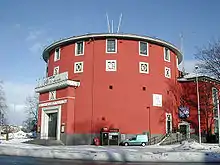
With students comprising almost a fifth of the population, the city of Trondheim is heavily influenced by student culture. Most noticeable is Studentersamfundet i Trondhjem, the city's student society. Its characteristic round, red building from 1929 sits at the head of the bridge crossing the river southwards from the city centre. As the largest university in Norway, the Norwegian University of Science and Technology (NTNU) is the host of some 36,000 students.[87]
Student culture in Trondheim is characterised by a long-standing tradition of volunteer work. The student society is for example run by more than 1,200 volunteers.[88] NTNUI, Norway's largest sports club, is among the other volunteer organisations that dominate student culture in Trondheim. Students in Trondheim are also behind two major Norwegian culture festivals, UKA and The International Student Festival in Trondheim (ISFiT). NTNU lists over 200 student organisations with registered web pages on its servers alone.[89]
In popular culture
Trondheim culture is parodied on the Monty Python album Another Monty Python Record in the form of the fictitious Trondheim Hammer Dance.[90]
Trondheim is also a key location in the Command & Conquer: Tiberian Sun universe, as it is a critical battleground for both factions.
Trondheim was the name of a planet in the Hundred Worlds of the Ender's Game novel series.
Sports and recreation
Granåsen Ski Centre, a Nordic skiing venue located in Byåsen, regularly hosts World Cup competitions in ski jumping, biathlon and cross-country skiing, as well as the 1997 FIS Nordic World Ski Championships. Trondheim attempted but failed to become the Norwegian candidate for the 2018 Winter Olympics. Hiking and recreational skiing is available around the city, particularly in Bymarka, which can be reached by the tramway. Trondheim Golfklubb has a nine-hole golf course in Byåsen.
Rosenborg BK is one of the city's two premier football clubs and plays their home matches at Lerkendal Stadion. They have won the Norwegian Premier League 26 times between 1967 and 2018, have reached the UEFA Champions League group stage 12 times, and made it to the last 8 on one occasion. Ranheim Fotball is the city's second premier football club having been promoted from the Norwegian First Division to join Eliteserien in 2018, coming in at seventh place out of 16 in its first season. Byåsen IL plays in the women's handball league, and is a regular in the EHF Women's Champions League, playing their home games at Trondheim Spektrum.
Trondheim and Trøndelag is also regarded as the home of the basse game.
Major sports teams
| Club | Sport | Founded | League | Venue |
|---|---|---|---|---|
| Rosenborg BK | Football | 1917 | Eliteserien (football) | Lerkendal stadion |
| Ranheim Fotball | Football | 1901 | Eliteserien (football) | EXTRA Arena |
| Byåsen | Handball (Women) | 1921 | Eliteserien (women's handball) | Trondheim Spektrum |
| Nidaros Hockey | Ice hockey | 2015 | 1. divisjon | Leangen Ishall |
| Trondheims-Ørn | Football (women) | 1972 | Toppserien | Koteng Arena |
| Kolstad Håndball | Handball (men) | 1972 | Eliteserien (men's handball) | Kolstad Arena |
| Spektra Cricket | Cricket | 2014 [91] | NCF Menn | Lade and Spektrum |
| Nidaros Jets | Basketball | 2014 | BLNO Menn | Husebyhallen |
Major championships hosted
| Event | Sport | Years | Venue |
|---|---|---|---|
| FIS Nordic World Ski Championships | Nordic skiing | 1997, 2025 | Granåsen |
| World Allround Speed Skating Championships | Speed skating | 1907, 1911, 1926, 1933, 1937 | Øya Stadion |
| IHF World Women's Handball Championship | Handball | 1993, 1999, 2023 | Trondheim Spektrum |
| IHF World Men's Handball Championship | Handball | 2025 | Trondheim Spektrum |
| European Men's Handball Championship | Handball | 2008, 2020 | Trondheim Spektrum |
| World Orienteering Championships | Orienteering | 2010 | Throughout Trondheim |
| UEFA Super Cup | Football | 2016 | Lerkendal Stadion |
Transportation
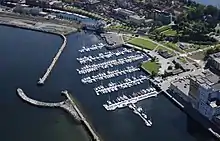
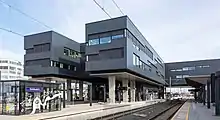
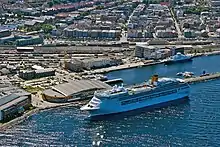
Trondheim has an international airport, Trondheim Airport, Værnes, situated in Stjørdal, which is Norway's fourth largest airport in terms of passenger traffic. Værnes has non-stop connections to cities such as London, Amsterdam, Copenhagen, and Stockholm, among others. The domestic route Trondheim – Oslo is among the busiest air routes in Europe with around 2 million passengers annually.
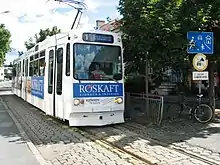
Major railway connections are the northbound Nordland Line, the eastbound Meråker Line to Åre and Östersund in Sweden, and two southbound connections to Oslo, the Røros Line and Dovre Line.
The Coastal Express ships (Hurtigruten: Covering the Bergen–Kirkenes stretch of the coast) call at Trondheim, as do many cruise ships during the summer season. Since 1994 there is also a fast commuter boat service to Kristiansund, the closest coastal city to the southwest. Every morning the Hurtigruten ships have one southbound and one northbound arrival and departure in Trondheim.
A car ferry route from the port of Flakk in the northwest of the municipality, connects Trondheim with Fosen. Various bridge projects over the Trondheim Fjord to replace the ferry have been planned, but none have begun construction.
Trondheim also boasts the northernmost (since closure of Arkhangelsk tram in 2004) tramway line in the world: the Gråkallen Line, the last remaining segment of the Trondheim Tramway, is an 8.8 kilometres (5.5 mi) route (which is mostly single-track outside the innermost parts of the city; except the stretch between Breidablikk and Nordre Hoem stations) which runs from the city centre, through the Byåsen district, and up to Lian, in the large recreation area Bymarka. Trondheim boasts the world's only bicycle lift, Trampe.
The bus network, operated by AtB, runs throughout most of the city and its suburbs. A new metro line system went public 3 August 2019. The new transportation system covers the Trondheim area (Trondheim, Malvik, and Melhus). The three metro lines and the city lines that link the city across. The new public transport system becomes flexible, with buses running more often and accommodating more passengers. Fewer travelers must take a detour through the center of Trondheim.
In addition, the Nattbuss (Night Bus) service ensures cheap and effective transport for those enjoying nightlife in the city centre during the weekends. The Nattbus has other prices than ordinary buses. The European route E6 highway passes through the city centre of Trondheim in addition to a motorway bypass along the eastern rim of the city.
Twin towns – sister cities
Trondheim is twinned with:[92]
 Darmstadt, Germany (1968)
Darmstadt, Germany (1968) Dunfermline, Scotland, United Kingdom (1945)
Dunfermline, Scotland, United Kingdom (1945) Graz, Austria (1968)
Graz, Austria (1968) Klaksvík, Faroe Islands (1987)
Klaksvík, Faroe Islands (1987) Kópavogur, Iceland (1946)
Kópavogur, Iceland (1946) Norrköping, Sweden (1946)
Norrköping, Sweden (1946) Odense, Denmark (1946)
Odense, Denmark (1946) Petah Tikva, Israel (1975)
Petah Tikva, Israel (1975) Ramallah, Palestine (2004)
Ramallah, Palestine (2004) Split, Croatia (1956)
Split, Croatia (1956) Tampere, Finland (1946)
Tampere, Finland (1946) Tiraspol, Moldova (1987)
Tiraspol, Moldova (1987) Vallejo, United States (1960)
Vallejo, United States (1960)
Planned partner city relations:
Business
- Lilleby smelteverk (1927–2002)
Notable people
Public Service & public thinking
_(3611228138).jpg.webp)
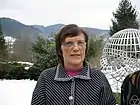
- Lisbet Nypan (ca.1610–1670) an executed alleged Norwegian witch
- Ove Bjelke (1611–1674) nobleman, feudal lord and Chancellor of Norway
- Albert Angell (1660–1705) landowner, businessman and Mayor of Trondheim
- Peter Tordenskiold (1691–1720) a Dano-Norwegian nobleman and flag officer[93]
- Hilchen Sommerschild (1756–1831) pioneer educator
- Frederik Due (1796–1873) Norwegian prime minister in Stockholm, 1841–1858
- Johan Thoning Owesen (1804–1881), shipowner, landowner and philanthropist
- Hans Gerhard Colbjørnsen Meldahl (1815–1877) politician and sixth Chief Justice of the Supreme Court of Norway, 1874–1877
- John Gunder North (1826–1872) ship builder in San Francisco
- Fritz Jenssen (1886–1966) banker and politician for Nasjonal Samling
- Bernt Ingvaldsen (1902–1985) politician, President of the Storting 1965–1972
- David Abrahamsen (1903–2002) forensic psychiatrist, psychoanalyst and author in the USA
- John Lyng (1905–1978) a politician, briefly Prime Minister of Norway in 1963
- Anne Margrethe Strømsheim (1914–2008) nurse and Norwegian resistance member
- Henry Thingstad (1916-1942) sports official, communist politician, and Norwegian resistance member
- Henrik Rogstad (1916–1945) a politician with Nasjonal Samling
- Cissi Klein (1929–1943 in Auschwitz) a Jewish girl, victim of the Holocaust
- Kaare Langlete (1931–2009) military officer and Lord Chamberlain
- Idun Reiten (born 1942) mathematician
- Per Arne Watle (born 1948) politician and CEO of Widerøe 1997–2008
- Erik Varden (born 1974) RC Bishop of Trondheim
The Arts


- Carl Lorck (1829–1882) a Norwegian painter
- Knut Glomsaas (1863–1935) a military musician
- Tupsy Clement (1871–1959) a Skagen painter of landscapes
- Emmy Worm-Müller (1875–1950) silent film actress [94]
- Arne Eggen (1881–1955) a classical composer and organist
- Bjarne Amdahl (1903–1968) pianist, composer and orchestra conductor [95]
- Erling Viksjø (1910–1971) architect, exponent of architectural modernism
- Agnar Mykle (1915–1994) author, controversial figure in Norwegian literature
- Arve Tellefsen (born 1936) classical violinist
- Liv Ullman (born 1938) actress and director [96]
- Jan Erik Kongshaug (1944–2019) sound engineer, jazz guitarist and composer [97]
- Sidsel Endresen (born 1952) singer, composer and actress
- Trond Halstein Moe (born 1954) operatic baritone
- Geir Lysne (born 1965) a jazz musician and Big Band leader
- Øystein Baadsvik (born 1966) tuba soloist and chamber musician
- Merethe Trøan (born 1970) singer at the 1992 Eurovision Song Contest
- Elise Båtnes (born 1971) violinist, leader of the Oslo Philharmonic orchestra since 2006
- Ingrid Lorentzen (born 1972) ballet dancer, artistic director of the Norwegian National Ballet
- Thomas Bergersen (born 1980) composer and multi-instrumentalist
Sports

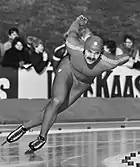
- Nils Uhlin Hansen (1919–1945) long jumper and Norwegian resistance member in WWII.
- Hjalmar Andersen (1923–2013) speed skater, triple gold medalist at the 1952 Winter Olympics
- Arnfinn Bergmann (1928–2011) ski jumper, gold medallist at the 1952 Winter Olympics
- Odd Iversen (1945–2014) a footballer with 282 club caps and 45 for Norway
- Jan Egil Storholt (born 1949) speed skater, gold medallist at the 1976 Winter Olympics
- Ingrid Kristiansen (born 1956) former long-distance runner
- Frode Rønning (born 1959) speed skater, bronze medallist at the 1980 Winter Olympics
- Rune Bratseth (born 1961) former footballer with 313 club caps and 60 for Norway
- Atle Kvålsvoll (born 1962) cyclist and coach
- Roar Strand (born 1970) footballer with 464 club caps and 42 for Norway
- Bjørn Otto Bragstad (born 1971) footballer with 251 club caps and 15 for Norway
- Gøril Kringen (born 1972) former footballer and coach
- Vegard Heggem (born 1975) former footballer with 20 caps for Norway
- Fredrik Winsnes (born 1975) former footballer with 353 club caps and 19 for Norway
- Øystein Kvaal Østerbø (born 1981) orienteering and ski-orienteering competitor
- Trine Rønning (born 1982) a former captain of the Norway women's national football team
- Emil Hegle Svendsen (born 1985) biathlete, eight medals at Winter Olympics (four gold)
- Torstein Horgmo (born 1987) snowboarder
- Emil Weber Meek (born 1988) mixed martial artist
- Jørgen Gråbak (born 1991) Nordic combined skier, double gold at the 2014 Winter Olympics
- Sander Sagosen (born 1995) handball player
- Alexander Sørloth (born 1995) footballer
- Johannes Høsflot Klæbo (born 1996) a cross-country skier, triple gold medallist at the 2018 Winter Olympics
See also
- List of mayors of Trondheim
- Norwegian Society for Photobiology and Photomedicine (1983)
- Tyholt Tower
References
- "Trondheim – 1601 (Sør-Trøndelag)". ssb.no/ (in Norwegian). Archived from the original on 5 February 2022. Retrieved 11 February 2022.
- "Folkemengde og areal i tettsteder 1. januar". ssb.no/ (in Norwegian). Archived from the original on 23 June 2017. Retrieved 1 January 2019.
- Statistisk sentralbyrå (2001). "Folke- og boligtellingen 2001, kommune- og bydelshefter 1601 Trondheim" (PDF) (in Norwegian). Archived (PDF) from the original on 14 June 2012. Retrieved 1 July 2009.
{{cite journal}}: Cite journal requires|journal=(help) - "Tabell 6 Folkemengde per 1. januar, etter fylke og kommune. Registrert 2010. Framskrevet 2011–2030, alternativ MMMM" (in Norwegian). Statistics Norway. Archived from the original on 22 February 2013. Retrieved 19 April 2011.
- Wells, John C. (2008). Longman Pronunciation Dictionary (3rd ed.). Longman. ISBN 978-1-4058-8118-0.
- Jones, Daniel (2011). Roach, Peter; Setter, Jane; Esling, John (eds.). Cambridge English Pronouncing Dictionary (18th ed.). Cambridge University Press. ISBN 978-0-521-15255-6.
- "Population, SSB". SSB. 27 February 2020. Archived from the original on 1 May 2020. Retrieved 1 March 2020.
- Bratberg, Terje T. V. (10 January 2008). "Striden om bynavnet". Arbeideravisa (in Norwegian). Trondheim. p. 27.
- Sjåvik, Jan (2010). The A to Z of Norway (The A to Z Guide Series Book 234). Scarecrow Press. p. 203. ISBN 9780810872134. Archived from the original on 28 May 2021. Retrieved 16 July 2019.
- Moore, Susan (20 June 2019). "The enduring enigma of the 'lost' Lewis chessmen". Financial Times. Archived from the original on 20 September 2019. Retrieved 16 July 2019.
- Nikel, David (2017). Moon Norway (Travel Guide). Moon Publications. p. 376. ISBN 978-1631214813. Archived from the original on 28 May 2021. Retrieved 16 July 2019.
- Brown, David (2000). Naval Operations of the Campaign in Norway, April–June 1940 (Naval Staff Histories). Routledge. p. 75. ISBN 0714651192. Archived from the original on 28 May 2021. Retrieved 16 July 2019.
- Hitlers drøm om Trondheim Archived 13 October 2007 at the Wayback Machine (in Norwegian)
- Jukvam, Dag (1999). "Historisk oversikt over endringer i kommune- og fylkesinndelingen" (PDF) (in Norwegian). Statistisk sentralbyrå. Archived (PDF) from the original on 3 October 2013. Retrieved 20 April 2011.
- Trondheim Kommune (17 June 2016). "Ja til sammenslåing av Klæbu og Trondheim" (in Norwegian). Archived from the original on 8 October 2017. Retrieved 8 January 2018.
- "Trondheim's coat of arms and seal". Trondheim kommune. Archived from the original on 8 December 2008. Retrieved 29 October 2008.
- "Trondheim, Norway – Sunrise, sunset, dawn and dusk times for the whole year – Gaisma". Gaisma.com. Archived from the original on 26 February 2021. Retrieved 1 July 2013.
- "See Norway's snow, weather, water and climate anytime anywhere". Archived from the original on 9 January 2008. Retrieved 29 December 2007.
- "Første frostnatt". 25 September 2013.
- "Over 1600 soltimer i Bergen" (in Norwegian). årstadposten. 25 June 2017. Archived from the original on 9 December 2018. Retrieved 25 June 2017.
- "Slik er været i fellesferien – statistisk sett". Met.no. 22 June 2021 [13 June 2021]. Retrieved 27 February 2022.
- "Været i april: Uvanlig varmt og tørt – VG". Verdens Gang. 29 April 2019. Retrieved 27 February 2022.
- "Tidenes solfest i Trøndelag i april". adressa.no. 29 April 2019. Retrieved 27 February 2022.
- "eKlima – Climate statistics for Norway from Meteorologisk Institutt (Norwegian Meteorological Institute)". January 2015. Archived from the original on 30 November 2016. Retrieved 13 March 2017.
- "Moyennes". March 2017. Archived from the original on 28 May 2021. Retrieved 13 March 2017.
- seklima.met.no
- "Trondheim". ESN Trondheim. 2 March 2014. Archived from the original on 25 June 2017. Retrieved 14 July 2017.
- "Bymarkbeveren skal holdes i sjakk" (in Norwegian). 24 October 2004. Archived from the original on 27 September 2007. Retrieved 3 August 2007.
- "Jerven som flyktet til byen" (in Norwegian). 8 May 2008. Archived from the original on 1 February 2009. Retrieved 9 May 2008.
- "Norges eldste jerv (18) er død" (in Norwegian). Archived from the original on 1 September 2017. Retrieved 1 September 2017.
- "Pilgrim ways in Norway, background". Trondheim kommune. Archived from the original on 23 August 2007. Retrieved 4 August 2007.
- "The consecration of King Harald and Queen Sonja". The Norwegian Royal Family. Archived from the original on 27 September 2007. Retrieved 3 August 2007.
- "The wedding of Princess Märtha Louise". The Norwegian Royal Family. Archived from the original on 30 September 2007. Retrieved 3 August 2007.
- "Pilegrimsleden (Miljøstatus i Norge)" (in Norwegian). Archived from the original on 17 March 2009.
- Raju, Alison (2010). The Pilgrim Road to Nidaros: St Olav's Way – Oslo to Trondheim. Cicerone Press Limited. ISBN 978-1-85284-314-4.
- Denham, Sean Dexter; Westling, Sara (2015). "Osteologiske og paleobotaniske undersøkelser av skjelett og jordprøve fra Sverresborg, Trøndelag Folkemuseum, Trondheim, Sør-Trøndelag" [Osteological & paleobotanical examinations of skeleton & soil sample from Sverresborg, Trøndelag Folkemuseum, Trondheim, Sør-Trøndelag] (PDF). Oppdragsrapport (in Norwegian). Universitetet i Stavanger. 8. Archived (PDF) from the original on 9 August 2020. Retrieved 16 July 2019.
- "11.7 Fangenskap i Norge" Archived 3 February 2014 at the Wayback Machine, NOU 1998: 12 Alta bataljon, regjeringen.no.
- "Trondheim Fengsel". Archived from the original on 29 December 2018. Retrieved 6 January 2019.
- Trondheim Prison dep. Leira, a study Archived 2012-09-07 at the Wayback Machine in Norwegian
- "Tall for Norge: Kommunestyrevalg 2019 – Trøndelag". Valg Direktoratet. Archived from the original on 24 October 2019. Retrieved 20 October 2019.
- "Table: 04813: Members of the local councils, by party/electoral list at the Municipal Council election (M)" (in Norwegian). Statistics Norway. Archived from the original on 19 April 2020. Retrieved 21 October 2019.
- "Tall for Norge: Kommunestyrevalg 2011 – Sør-Trøndelag". Valg Direktoratet. Archived from the original on 13 April 2020. Retrieved 20 October 2019.
- "Kommunestyrevalget 1995" (PDF) (in Norwegian). Oslo-Kongsvinger: Statistisk sentralbyrå. 1996. Archived (PDF) from the original on 20 September 2014. Retrieved 12 April 2020.
- "Kommunestyrevalget 1991" (PDF) (in Norwegian). Oslo-Kongsvinger: Statistisk sentralbyrå. 1993. Archived (PDF) from the original on 22 May 2015. Retrieved 12 April 2020.
- "Kommunestyrevalget 1987" (PDF) (in Norwegian). Oslo-Kongsvinger: Statistisk sentralbyrå. 1988. Archived (PDF) from the original on 19 October 2014. Retrieved 12 April 2020.
- "Kommunestyrevalget 1983" (PDF) (in Norwegian). Oslo-Kongsvinger: Statistisk sentralbyrå. 1984. Archived (PDF) from the original on 19 October 2014. Retrieved 12 April 2020.
- "Kommunestyrevalget 1979" (PDF) (in Norwegian). Oslo: Statistisk sentralbyrå. 1979. Archived (PDF) from the original on 29 September 2014. Retrieved 12 April 2020.
- "Kommunevalgene 1975" (PDF) (in Norwegian). Oslo: Statistisk sentralbyrå. 1977. Archived (PDF) from the original on 15 March 2016. Retrieved 12 April 2020.
- "Kommunevalgene 1972" (PDF) (in Norwegian). Oslo: Statistisk sentralbyrå. 1973. Archived (PDF) from the original on 21 April 2016. Retrieved 12 April 2020.
- "Kommunevalgene 1967" (PDF) (in Norwegian). Oslo: Statistisk sentralbyrå. 1967. Archived (PDF) from the original on 21 April 2016. Retrieved 12 April 2020.
- "Kommunevalgene 1963" (PDF) (in Norwegian). Oslo: Statistisk sentralbyrå. 1964. Archived (PDF) from the original on 21 April 2016. Retrieved 12 April 2020.
- "Kommunevalgene og Ordførervalgene 1959" (PDF) (in Norwegian). Oslo: Statistisk sentralbyrå. 1960. Archived (PDF) from the original on 17 March 2016. Retrieved 12 April 2020.
- "Kommunevalgene og Ordførervalgene 1955" (PDF) (in Norwegian). Oslo: Statistisk sentralbyrå. 1957. Archived (PDF) from the original on 14 February 2020. Retrieved 12 April 2020.
- "Kommunevalgene og Ordførervalgene 1951" (PDF) (in Norwegian). Oslo: Statistisk sentralbyrå. 1952. Archived (PDF) from the original on 17 March 2016. Retrieved 12 April 2020.
- "Kommunevalgene og Ordførervalgene 1947" (PDF) (in Norwegian). Oslo: Statistisk sentralbyrå. 1948. Archived (PDF) from the original on 16 March 2016. Retrieved 12 April 2020.
- "Kommunevalgene og Ordførervalgene 1945" (PDF) (in Norwegian). Oslo: Statistisk sentralbyrå. 1947. Archived (PDF) from the original on 25 August 2014. Retrieved 12 April 2020.
- "Kommunevalgene og Ordførervalgene 1937" (PDF) (in Norwegian). Oslo: Statistisk sentralbyrå. 1938. Archived (PDF) from the original on 6 March 2016. Retrieved 12 April 2020.
- "Kommunevalgene og Ordførervalgene 1934" (PDF) (in Norwegian). Oslo: Statistisk sentralbyrå. 1935. Archived (PDF) from the original on 5 March 2016. Retrieved 12 April 2020.
- "Kommunevalgene og Ordførervalgene 1931" (PDF) (in Norwegian). Oslo: Statistisk sentralbyrå. 1932. Archived (PDF) from the original on 21 April 2016. Retrieved 12 April 2020.
- "Kommunevalgene og Ordførervalgene 1928" (PDF) (in Norwegian). Oslo: Statistisk sentralbyrå. 1929. Archived (PDF) from the original on 21 April 2016. Retrieved 12 April 2020.
- "Kommunevalgene og Ordførervalgene 1925" (PDF) (in Norwegian). Oslo: Statistisk sentralbyrå. 1926. Archived (PDF) from the original on 25 August 2014. Retrieved 12 April 2020.
- "Kommunevalgene og Ordførervalgene 1922" (PDF) (in Norwegian). Oslo: Statistisk sentralbyrå. 1923. Archived (PDF) from the original on 21 April 2016. Retrieved 12 April 2020.
- "Kommunevalgene og Ordførervalgene 1919" (PDF) (in Norwegian). Oslo: Statistisk sentralbyrå. 1920. Archived (PDF) from the original on 5 March 2016. Retrieved 12 April 2020.
- "Kommunevalgene og Ordførervalgene 1916" (PDF) (in Norwegian). Oslo: Statistisk sentralbyrå. 1917. Archived (PDF) from the original on 27 January 2021. Retrieved 12 April 2020.
- "Kommunevalgene og Ordførervalgene 1913" (PDF) (in Norwegian). Oslo: Statistisk sentralbyrå. 1914. Archived (PDF) from the original on 31 August 2018. Retrieved 12 April 2020.
- Fossen, Christian. "Norwegian University of Science and Technology". ntnu.edu. Archived from the original on 6 December 2019. Retrieved 11 April 2017.
- "Scholarships". BI Business School. Archived from the original on 11 April 2017. Retrieved 11 April 2017.
- "About us – SINTEF". Sintef.no. 18 June 2013. Archived from the original on 12 June 2008. Retrieved 1 July 2013.
- no:Ila skole (Trondheim)
- Haugan, Trond E (2008). Byens magiske rom: Historien om Trondheim kino. Tapir Akademisk Forlag. ISBN 978-82-519-2242-5.
- "Lanserer ny lokalavis i Trondheim". Archived from the original on 28 November 2019. Retrieved 26 November 2019.
- "Radiokanaler på DAB". Archived from the original on 27 September 2017. Retrieved 8 January 2018.
- Archived 7 December 2007 at the Wayback Machine
- "Nordenfjeldske". Archived from the original on 11 June 2009. Retrieved 22 December 2009.
- "Trøndelag senter for samtidskunst". Kunzt.no (in Norwegian). Archived from the original on 26 February 2021. Retrieved 19 October 2020.
- Caron, Vittoria (2 January 2017). "10 Must-Visit Contemporary Galleries in Trondheim, Norway". Culture Trip. Archived from the original on 20 January 2021. Retrieved 19 October 2020.
- "this is a political (painting)". e-flux. 5 October 2016. Archived from the original on 16 July 2020. Retrieved 16 July 2020.
- "Kunsthall Trondheim". Kunzt.no (in Norwegian). Archived from the original on 28 May 2021. Retrieved 19 October 2020.
- Haugan, Trond E. Byens magiske rom: Historien om Trondheim kino (Tapir Akademisk Forlag, 2008, ISBN 978-82-519-2242-5) Norwegian
- "About". Teater Fusentast. Archived from the original on 4 March 2016. Retrieved 21 May 2015.
- Nicholson, Stuart (1 May 2014). Is Jazz Dead?: Or Has It Moved to a New Address. Routledge. ISBN 978-1136731006.
- "History". Jazzfest. Archived from the original on 21 May 2015. Retrieved 21 May 2015.
- "Jazz Fest". Archived from the original on 21 May 2015. Retrieved 21 May 2015.
- "Rockheim". Rockheim. Archived from the original on 26 May 2015. Retrieved 21 May 2015.
- "Det nasjonale opplevelsessenteret for pop og rock i Trondheim vil ligge på Brattøra". Regjeringen. Archived from the original on 21 May 2015. Retrieved 21 May 2015.
- Skybakmoen, Jonas (5 August 2010). "Rocken kommer heim". Adressa. Archived from the original on 22 February 2014. Retrieved 21 May 2015.
- "NTNU blir størst". Khrono. 28 January 2015. Archived from the original on 3 April 2016. Retrieved 25 February 2016.
- "About Studentersamfundet" (in Norwegian). Archived from the original on 9 November 2007. Retrieved 18 February 2008.
- "NTNU Student Organisations (in Norwegian)". Archived from the original on 6 March 2008. Retrieved 18 February 2008.
- "Apologies/ Trondheim Hammer Dance". madmusic.com. Archived from the original on 7 December 2013. Retrieved 12 October 2012.
- "Spektra Cricket Klubb i Trondheim". Archived from the original on 25 January 2021. Retrieved 27 May 2021.
- "Internasjonalt arbeid". trondheim.kommune.no (in Norwegian). Trondheim Kommune. Archived from the original on 14 April 2021. Retrieved 14 April 2021.
- Bain, Robert Nisbet (1911). . Encyclopædia Britannica. Vol. 27 (11th ed.). pp. 50–51.
- IMDb Database Archived 16 February 2017 at the Wayback Machine retrieved 10 November 2020
- IMDb Database Archived 18 February 2017 at the Wayback Machine retrieved 10 November 2020
- IMDb Database Archived 10 November 2020 at the Wayback Machine retrieved 9 November 2020
- IMDb Database Archived 1 November 2020 at the Wayback Machine retrieved 10 November 2020
Further reading
- Trondheim: One Thousand Years in the City of St. Olav. Strindheim trykkeris forlag. 1992. ISBN 8290551576.
External links
- Municipality website (in Norwegian)
- Trondheim.no, Trondheim's official website in Norwegian
- and Trondheim.com, Trondheim's official website in English
- Bain, Robert Nisbet (1911). . Encyclopædia Britannica. Vol. 27 (11th ed.). p. 305.
- Visit Trondheim
 Trondheim travel guide from Wikivoyage
Trondheim travel guide from Wikivoyage


